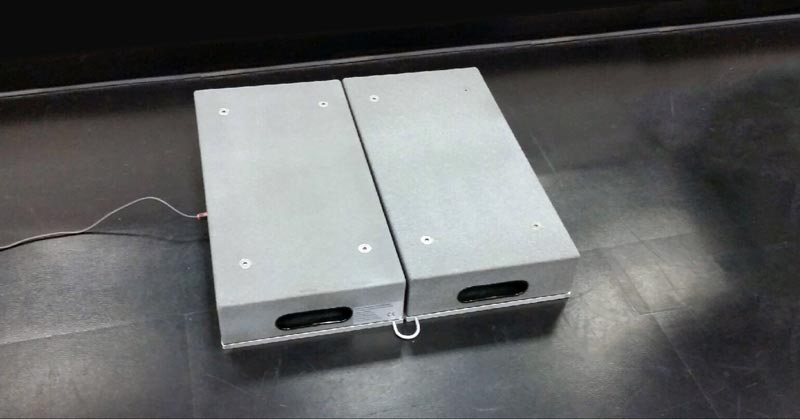
By Bennet Watson, Managing Director, zFlo, Inc.
The promise of many new “sport-science” devices is very much alluring; we all want a device that can instantly capture research grade data and wirelessly connect to one’s phone with minimal investment. As a company, we know and recognize the potential that exists with accelerometers and gyroscopes – our company sells an IMU-based motion-analysis system that is a great tool for many clinical rehabilitation users, but there is a major difference between professional wearable systems and many of the devices that are currently entering the market. The gap between validated and objective measurement systems for professionals and consumer products marketed beyond their abilities is enormous. The traditional view is that there are two (sometimes) opposing categories: research systems and practical applications. Those days are long over. You do not have to compromise your data integrity – with the proper software, force-plates are just as easy to use and just as convenient as any wearable system. Are the wearable tools you are using to test athletes legit, or just hype?
Unfortunately, when hyped-up wearable products are tested for validity, the numbers just don’t add up. The result is that teams are left with junk data. This could mean literally years of important information lost because the measurement tool simply didn’t provide accurate and precise data. Even worse, teams are targeted as marketing pawns to project credibility onto start-up companies, and when the next round of funding comes, teams are eventually orphaned in favor of large consumer volumes that investors crave. Every few years this entire masquerade repeats, and college and professional teams soon go back to their old, technology-free ways, tired of being burned. My company has been providing tools to the top professionals in sport, healthcare, and research for over ten years now, and we will share the problems you are likely facing in sports science and explain what success looks like when real research-grade tools are employed. The goal of this guest article is not to use scare tactics to sell our services, but a necessary response to what we have seen over the last few years. The trend of hype and sell is rising, and if we can successfully educate the reader to what we see on a daily basis, then we have done our job. If we can emphasize one important lesson it is this: do your homework and be vigilant; dubious marketing gets slicker every day and will only become more deceptive. Ask yourself what the final result of your testing is – are you buying a cool device, or are you buying a solution?
An Inconvenient Truth with Sports Technology
A quick rundown of painfully learned lessons is listed here, all in brutal detail and honesty. Before you make any decisions about what you are investing into with sports technology, think about what you are promised to receive (in data) and ask if the company can fulfill and deliver it. When we work with professional teams and universities, the sheer amount of misinformation and marketing lies we have to debunk is frightening. Our business is working with professionals at every level, and that means we are not slaves to investors wanting millions of users to be looking at a smartphone app. Our business is supporting professionals that have their job on the line, not entertaining fitness consumers or trying to be acquired by Fitbit.
Lesson One
Reducing injuries means medical grade, not consumer level.
When working with a dual force plate and not a body sensor, the practitioner is collecting medical grade data one observes in the research papers. The use of weightlifting sensor technology is important, but direct testing of athletic movement is more predictive in nature. Average or Mean Power is a useful option for strength and conditioning coaches needing acceptable numbers, but for making career shaping decisions, force plates are the correct choice. Zeroing in on whether an ACL rehabilitation program is or is not doing its job should be a priority for multi-million dollar athletes or scholarship players. Basing decisions on cheap accelerometers from Asia is an expensive mistake – leave the micro sensors to pedometers and smartphones.
Lesson Two
If you hear “proprietary algorithms” it really just means “estimations.”
Eventually in time, very extensive and complicated calculations will be able to get measurements that replicate the gold standard tools, but most companies are not allocating resources to get high precision, especially when consumers are buying products before they are even available through well-marketed and positioned crowdfunding campaigns. The future is certainly exciting, but banking on device companies is rolling the dice: rather than getting data that directly assess forces, one is using statistical shortcuts. Keep in mind the weak link with calculations is the expensive costs of hiring qualified engineers rather than hoping Silicon Valley has enough college interns to do the job properly. Always ask the question who is deciding the fate of when an exercise is deemed valid, and think profits over science.
Lesson Three
Quality of data is a responsibility, not a luxury item.
Budgeting is a real plight for teams and clinics wanting to make improvements to athlete training or patient care. It’s better not to have a device or system giving dirty data and wait for a tool that appears to be a better option. The emotional comfort of having numbers does satisfy the itch to be doing something, but only valid information is helping the problem. Professional responsibility is an ethical dilemma, not something to be treated like improvements to nonessential nice-to-haves. It’s fine for staff to get excited about big ticket items like player tracking systems and force plates, but it’s also necessary when deciding the fate of an athlete’s body that is expected to be protected and developed.
Lesson Four
Sports performance data doesn’t mean telemedicine.
Continuous monitoring is useful for physiological data, but having a wearable on means the data is always collecting, and this means a lot of noise to sift through. A better option is properly evaluating standardized tests that have proven to be valid in published research. Based on the extensive research in Cologne, Germany, the subtle information on the force-time plot is more telling than an uncontrolled wild-west data dump. A real-time pipeline is just great in theory, but we are not there yet with reliable measurements to adjust and correct movements without controlled procedures. Our software does automatically detect invalid test performances, but the main point is that real insight comes from peeling the onion back more rather than getting more and more data.
Lesson Five
Invest in the future, don’t impulse buy for today.
A lot of teams feel pressured to keep up with the so-called arms race with sports technology and data. The wise way to handle the propaganda is to have a process in place that educates management and administration before the email reaches your inbox. No figurehead likes being last or late, but being too early also is a public blunder when most device companies are rushing to market and are exposed later. A force plate’s purpose is for industrial use, so it’s not fragile technology by any means and has proven itself over and over. Most force plates we have set up last longer than many companies in sports technology stay in business. When you are buying a force plate you are investing into the next decade or more; you are not buying something to give preseason media releases to write about that will collect dust next year.
What zFlo Force Systems Can Do for You
I can list more lies and warning lessons, but it’s not necessary. Just exposing the tip of the iceberg can simply alarm professionals in health and human performance to be skeptical and alerted.
If you are serious about providing quality of care to your athletes and are committed to bringing research grade data to your facility, we have made the task of integrating systems directly into the weight room or rehabilitation space. All our options are aligned with a core mission, bringing sports technology and the professional together. What we share with our clients is why we are promoted organically on podcasts and word of mouth from professional teams. We are here to serve anyone that is seeking to better understand motion of the human body and how it impacts every aspect of life – from athletics to clinical rehabilitation, product development, and consumer satisfaction, we know first-hand how powerful information can be when properly applied. So reach out to us and let’s talk about your goals with data-collection. Whether you already have force plates and simply need a software that can do the important calculations automatically and in a quick and easy workflow, or you’re interested in acquiring a set of plates – we want to hear from you.
Please share so others may benefit.
[mashshare]


Greetings,
Interesting article. We are interested in adding a modern test for Power to our Fitness evaluations for tactical athletes (firefighters and police officers). Please send us some information about dual force plates and their pricing.
Thanks,
Derek